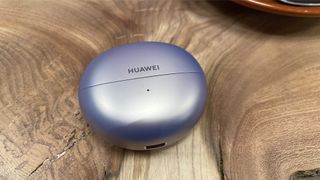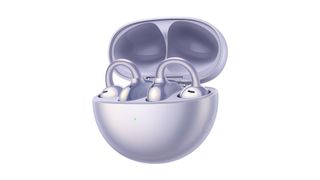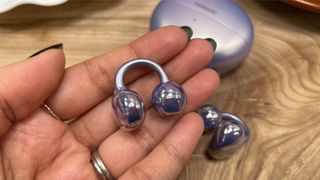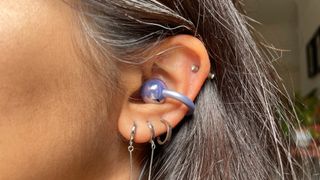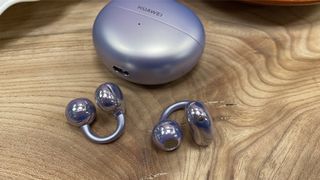Is it an earring? Is it a Jeff Koons modern art piece? No, it’s Huawei’s latest wireless earbuds, and we’ve never seen anything like them before.
Called the Huawei FreeClip, this odd-looking pair takes advantage of an “open” fit design. This means that you can listen to music while being entirely aware of your surroundings at all times, and it offers an alternative, less intrusive design compared with conventional earbuds where an eartip burrows into your ear.
Yes, these earbuds look incredibly odd and they have piqued our interest. But is the innovative design a success? Let’s find out.
Price
The Huawei FreeClip are available to buy for £180 directly from the brand’s UK store or on Amazon in both black and purple finishes. While not available to buy in the USA, this price tag translates to approximately $230 in today’s current conversion rate, while Australian customers can buy the distinctive buds for around AU$320.
There isn’t any direct rival for the FreeClip’s specific design purpose, but at this price bracket, there are plenty of great five-star earbuds available, such as the Sony WF-C700N (£100), the JBL Live Pro 2 TWS (£130) and even the Apple AirPods Pro 2 (£229).
The best “open” style earbuds we’ve tested so far are Sony’s Linkbuds (WF-900), whose compact, light design and balanced, natural sound impressed us for £150 / $180 / AU$300. Huawei’s FreeClip, however, is a wildly different design.
Design & comfort
Let’s talk about that design. Each earbud consists of two shapes – a round ‘acoustic ball’ that nestles in your ear’s concha and a larger ‘comfort bean’ that sits behind the ear to provide support – that are connected by what Huawei calls a ‘C-bridge’. This connector is flexible, made of a nickel-titanium memory shape alloy that flexes and settles to the ideal position as you put the earbuds on. Extensive tests were done to ensure this crucial connector has just the right clamping force for the buds to remain secure and comfortable. We tentatively twisted and extended the connector, too – it certainly feels strong and durable enough to withstand long-term wear.
Wearing the FreeClip buds is quite simple: you effectively slide them on around the edge of your ear like clip-on ear cuffs, placing them so that the round acoustic ball (the one with the driver) points towards your ear canal. It takes us a couple of tries to make sure we put them on the right way round, but once you slip them on, they do make sense. Here, the FreeClip’s main USP is that it leaves your ear canal free.
We’ll admit, we’re not overly fond of the bulbous, shiny design of the earbuds. It looks rather cartoonish, but we can imagine potential customers being either repulsed or attracted to this design that looks so ‘different’ to the norm. The large size does make us wonder how we’ll ever be comfortable wearing them – and we’re happy to be proven wrong.
Huawei FreeClip tech specs
Type True wireless earbuds
Bluetooth 5.3
Codec support AAC, SBC, LC3, L2HC
Active noise-cancelling? No
Spatial Audio? No
Battery life 8 hours (earbuds), total 36 hours (with charging case)
Finishes x2 (purple, black)
Earbuds weight 5.6g
Charging case weight 44.5g
Despite our reservations about the earbuds’ aesthetics, we are surprised by just how incredibly light and comfortable they are when wearing them. The ‘clip on’ earbuds weigh only 5.6g overall and hang on gently to our ears, and the clamping pressure is judged perfectly. They stay in place securely, and the pressure is so light on our ears that we forget we’re even wearing them after the first few seconds. Even those of us on the review team who wear glasses or have multiple ear piercings found them comfortable, with no part of the buds’ design causing issues.
With no need to find the right ear tip size or the perfect fit, all you have to do is make sure they’re sitting at the right angle for comfort and that the sound is directed to your ear.
Inside each bud is a “high-sensitivity” dual magnetic moving coil driver, which Huawei claims delivers a powerful, clear sound. To reduce any sound leakage because of this open audio technology, the brand uses a “reverse sound field acoustic system” that keeps your conversations private while retaining that “open” feel.
There are some caveats. They don’t clamp too tightly, thankfully, but that does mean that any vigorous head shaking or hair-flipping can dislodge them. The IP54 rating for dust and sweat resistance means they’re fine for a light run in drizzly conditions, but we’d avoid them if you’re into intense aerial acrobatics or are out in heavy rain. The keen runners on our review team said they were impressed with how the FreeClip stayed put, but would prefer the hook or wingtip designs of the Beats Fit Pro or Bose QC Ultra Earbuds for a firmer, more secure fit for sports and marathon training.
Features
One clever thing about the FreeClip’s design is that there’s no left or right bud. Both earbuds are identical so they can be worn interchangeably and placed in either compartment in the charging case.
General connectivity is seamless. They pause and resume music playback when the earbuds are taken out of our ears (and placed back in), the Bluetooth connection with our iPhone is swift and fuss-free, and they reconnect instantly every time we take them out of their charging case. The FreeClip support the standard SBC and AAC Bluetooth codecs alongside the newer LC3 codec, which requires a compatible source.
Battery life is respectable for the price point, too, with eight hours of music playback on a single charge and an impressive total of 36 hours with the charging case. We found these figures to run true in real-life use, with the buds lasting a long time without needing to reach for the USB-C cable or wireless charging pad. A quick ten-minute charge will give you three hours of extra juice.
One area in which we find the FreeClip frustrating is with the touch controls. You can tap the main parts of the earbud’s body to pause/play, answer a call or skip songs, but the operation is very hit-and-miss. Instead of a single tap, you have to double- or triple-tap for those actions, but they’re simply not responsive every time. We try multiple times to make them work consistently, but after a while, we give up. We think these basic controls should work instinctively and smoothly in all earbuds, regardless of the innovation of their design.
Another disappointment we have is with the EQ presets you get in the Huawei Life app. Aside from the Default setting, you can choose between Treble boost, Voices and Elevate presets to adjust the balance of the sound, but they, in order, tend to sharpen an already bright treble, narrow the dynamics further or recess the vocals in favour of fatter bass. We found the effects to be imbalanced and unsatisfying. We wish Huawei could have included a custom equaliser so we could manually fine-tune the earbud’s balance to our own sonic preferences.
Call quality
The call quality in today’s wireless earbuds is, in general, competent, so it’s a surprise to hear such a drop in quality when using the FreeClip during work calls over the phone and video. The buds feature two microphones and a voice pick-up unit, with technology that aims to cancel out noise and wind interference. But even when indoors in a fairly quiet environment, it’s not a smooth experience.
The recipient on the other end noted that our voice sounded rather coarse and not clean, with a hard edge to the upper mids. We also experienced a few interruptions and glitches over the call, and found the caller to sound less full-bodied than we normally would. Overall, we didn’t find it a smooth or natural sounding quality, especially when compared with rival earbuds.
It’s worth noting that voice calling is stated as more draining on the FreeClip’s battery than playing music, reducing battery life to five hours (or 20 hours in total with the case) when using it for calls. If your priority for a pair of earbuds is the quality of voice and video calls, we’d look elsewhere.
Sound
In terms of letting you hear the outside world entirely and at all times, the FreeClip certainly fits the brief. You can hear every bird song, office chatter, traffic and wind noise with clarity. The open ear audio technology essentially fires sound towards your ear canal, but the “open” aspect works both ways, as the earbuds leak sound, too. They’re nowhere near as leaky as a pair of Grado over-ears, but anyone sitting next to you will be able to hear the faint tinny beat of a song playing.
The open design also means you don’t need any ‘speak to chat’ or ‘conversation mode’ feature as you’d find on Sony’s and Apple’s earbuds, and you don’t need to take them off to interact with the world around you. There’s no active noise-cancelling here of course, and you can’t dial back how much of the outside world you let in, either. The main point is to hear everything around you as clearly as if you weren’t wearing any earbuds at all.
Which leaves little room for the music. We’re not expecting the solid, weighty sound or deep bass you get with a good seal on conventional earbuds, but we were hoping for far more detail and rhythmic prowess than we hear with the Huawei FreeClips.
Songs sound rather one-dimensional, with not enough detail, dynamics or drive to hold our interest. There’s little warmth or natural tone to voices or instruments, and while we’re not expecting much in the way of deep bass, the sound is thin and top-heavy. If you enjoy listening to podcasts while out and about, forget about it – the tinny edge and sound of traffic will drown out the voices. This is where we wish we could dial up the midrange EQ ourselves; simply cranking up the volume isn’t an adequate solution.
We still think that the FreeClip earbuds should sound entertaining and capable while accompanying you on your day’s activities. The sound is clean and some songs have punch – we get hints of the funky beat in Players by Coi Leray – but if you were hoping for the meaty, driving rhythm of Saliva’s I Walk Alone to pump you through a workout, you’ll be disappointed. The complexities of a full John Williams orchestra or the gentle melody of an Elliott Smith song will be lost to the wind – sometimes literally.
We miss the natural warmth, depth and solidity when listening to our favourite tunes and wish we could hear more detail and distinction between notes and instruments. Our closest rival to the FreeClip is the Sony Linkbuds; these also suffer from a lack of bass due to their open design, but they sound far more substantial,l and musically they’re so much more engaging. There’s ample detail and rhythmic ability, with enough warmth and insight – you can hear more of the music, too. We can still appreciate the musical integrity of a song while being aware of our surroundings with the Sonys, and we wish the Huawei were better balanced in a similar way.
Verdict
We applaud Huawei for doing something different and pulling off a unique design that works, to a degree. If you find the usual eartip design uncomfortable or are worried about the long-term health issues of having sound fired directly into your ear canal, the FreeClip offer a convincing alternative. They do cater to a particular niche use-case, but even then we think those using these as background listening buds deserve a better quality of voice calls and music playback.
It’s a tale of two halves: the comfortable all-day, open wear of this unique design is spot-on, but the basics of reliable control and sound quality aren’t at an acceptable level for today’s standard for wireless earbuds. We think this is a decent first draft; here’s hoping Huawei’s second attempt can only improve upon this solid design base and focus a bit more on the music next time.
SCORES
- Sound 2
- Comfort 5
- Features 3
MORE:
Also consider the Sony Linkbuds WF-L900
Best in-ear headphones: budget to premium






